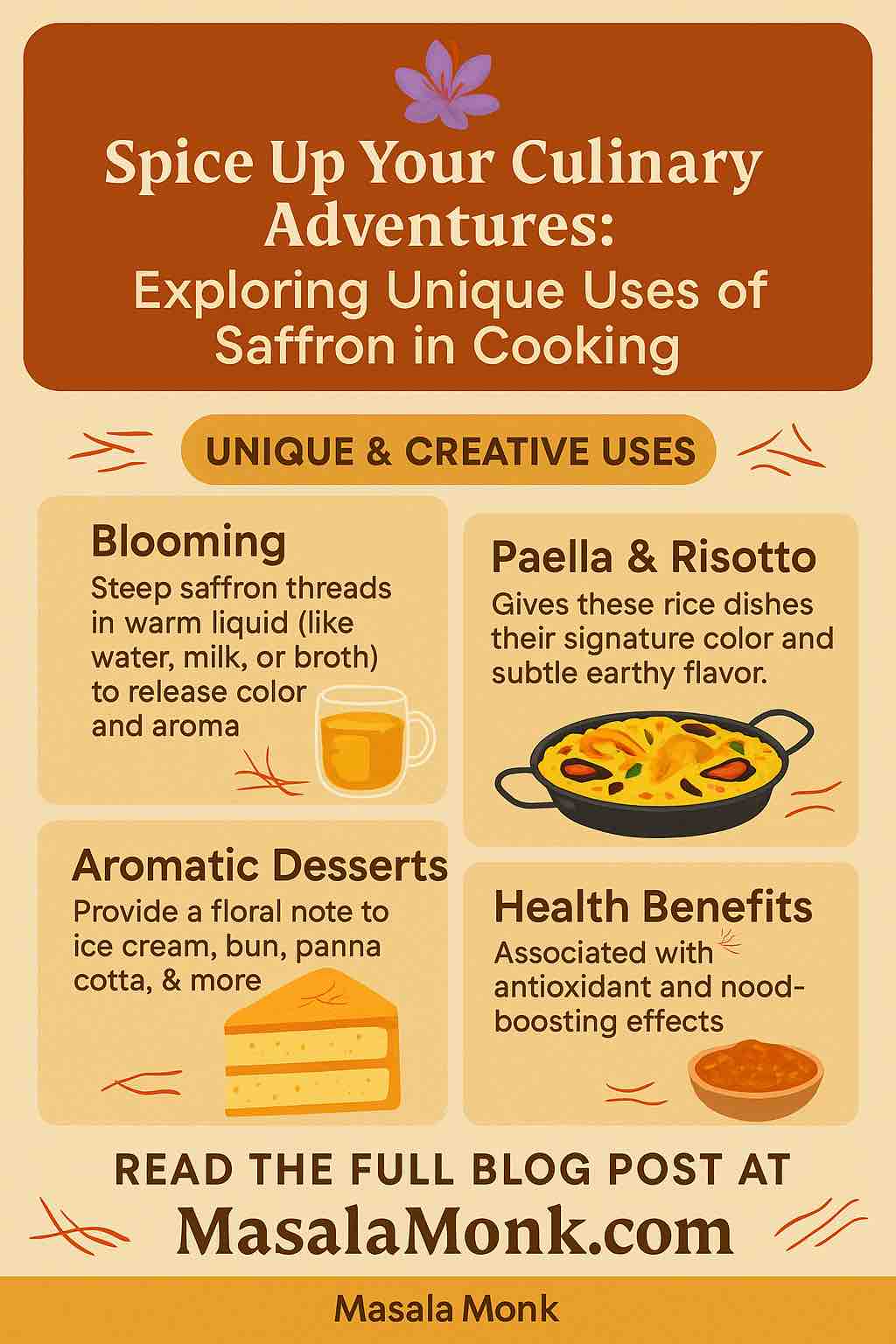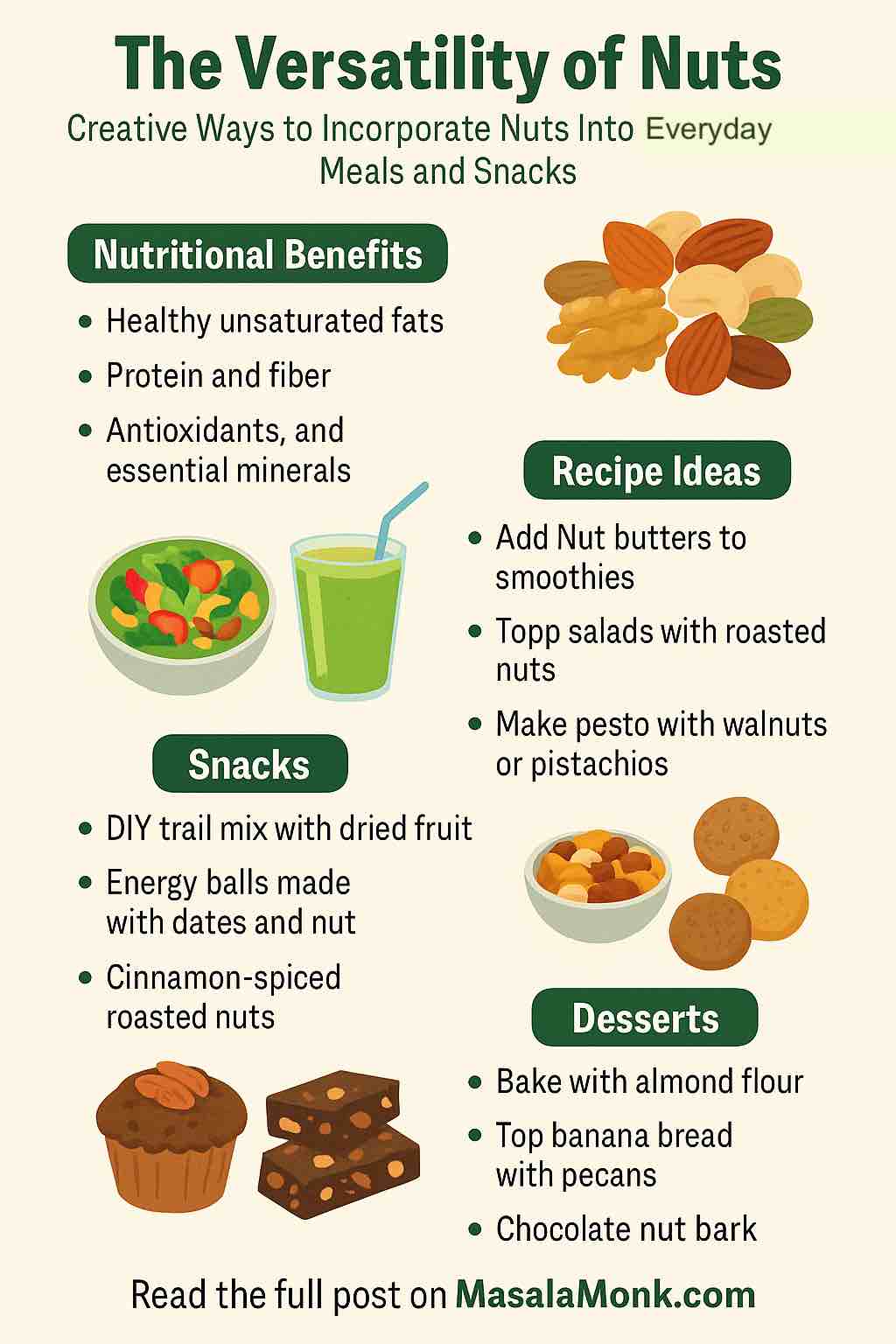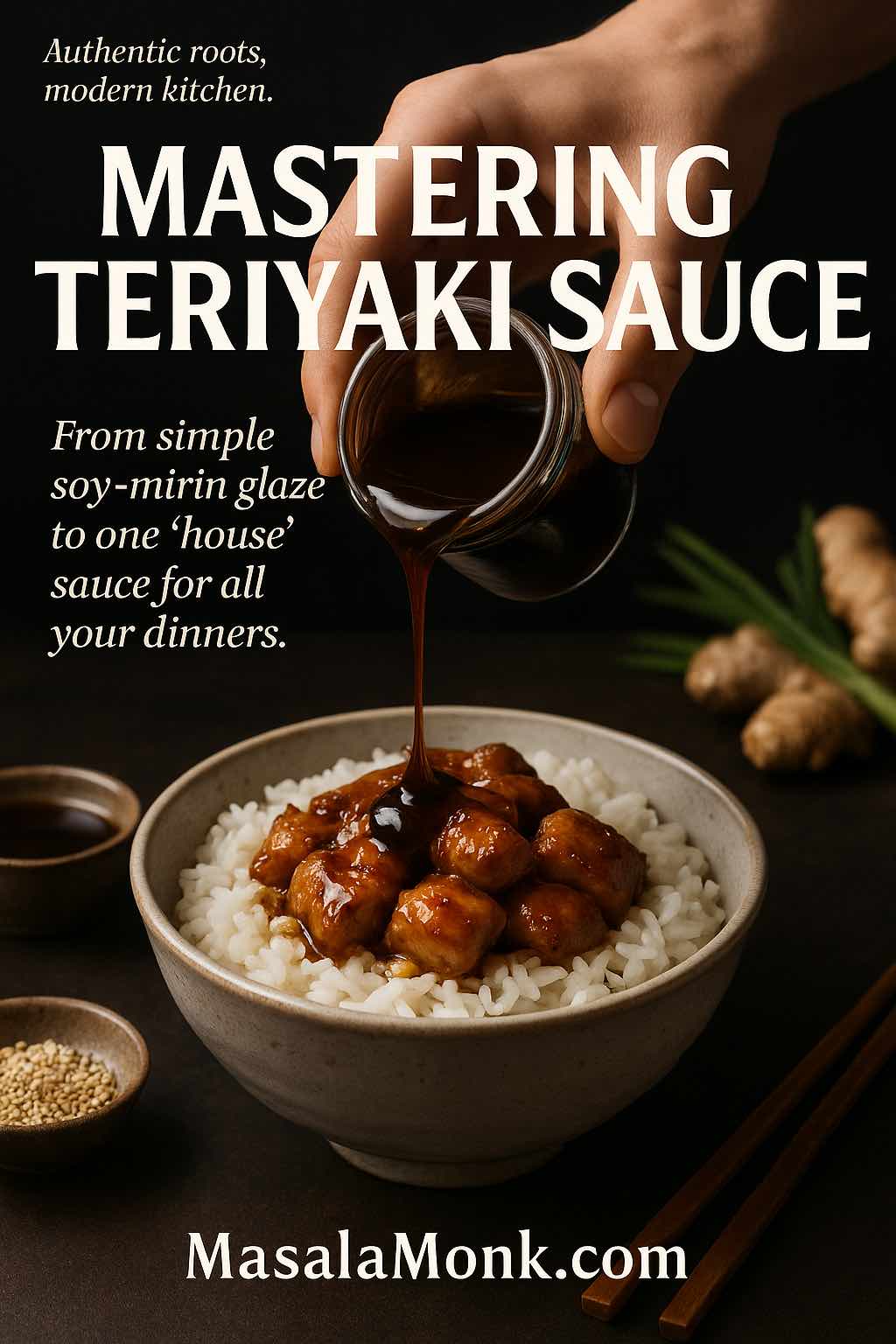
Teriyaki is one of those flavours that makes plain food feel like an actual meal. A bowl of rice and vegetables is nothing special; spoon a glossy, sweet–savory teriyaki sauce over the top and suddenly it looks like something from a Japanese grill. The same happens to chicken thighs, salmon fillets, tofu cubes, even roasted potatoes. A teriyaki sauce recipe is simple at its core, but endlessly flexible in practice.
The confusion starts when you realise “teriyaki sauce” means very different things to different people. In Japan, it began as a simple glaze made with soy sauce, mirin and sugar, brushed repeatedly onto grilled fish or chicken. Outside Japan, it grew thicker, sweeter and more garlicky, eventually showing up in bottles, takeout shops and fusion recipes ranging from teriyaki pizza to teriyaki burgers. Then the health-conscious crowd arrived and the questions multiplied: low sugar teriyaki, low sodium teriyaki, keto teriyaki, vegan teriyaki, soy-free teriyaki… are those even still “teriyaki”?
This post is meant to be your one-stop answer. We’ll walk through what teriyaki actually is, how to make a reliable homemade teriyaki sauce, how to cook a more traditional Japanese-style version, and how to spin that base into marinades, stir-fry sauces, glazes, dips and dressings. After that, we’ll look at the most useful flavour variations and finish with ways to make teriyaki lighter and friendlier for everyday eating, without turning it into a completely different sauce.
Throughout, think of teriyaki as joining the same “core sauce” family as pesto, béchamel and tzatziki—sauces that MasalaMonk has already taken deep dives into in posts like the basil-packed pesto variations, classic béchamel for lasagna and refreshing Greek tzatziki recipes. Once you know the base, you can bend it in all sorts of directions.
What “Teriyaki” Really Means
The word comes from two Japanese elements: teri, which refers to shine or luster, and yaki, meaning grilling or broiling. If you look at the description on Wikipedia’s teriyaki page, you’ll see that originally it wasn’t a bottled sauce at all, but a method of cooking: fish or meat was grilled while being brushed with a mixture of soy sauce, mirin and sugar, sometimes sake as well. The sugar and mirin helped the glaze caramelise and created that characteristic glossy coat.
In that setting:
- the focus was on the technique of basting and grilling
- the glaze was a simple blend of soy, mirin, sugar and maybe sake
- the sauce itself stayed fairly thin and syrupy, not thick like gravy
Classic examples include teriyaki yellowtail, teriyaki mackerel and teriyaki chicken. The glaze was cooked directly onto the surface of the food. It wasn’t something served in a ramekin on the side.
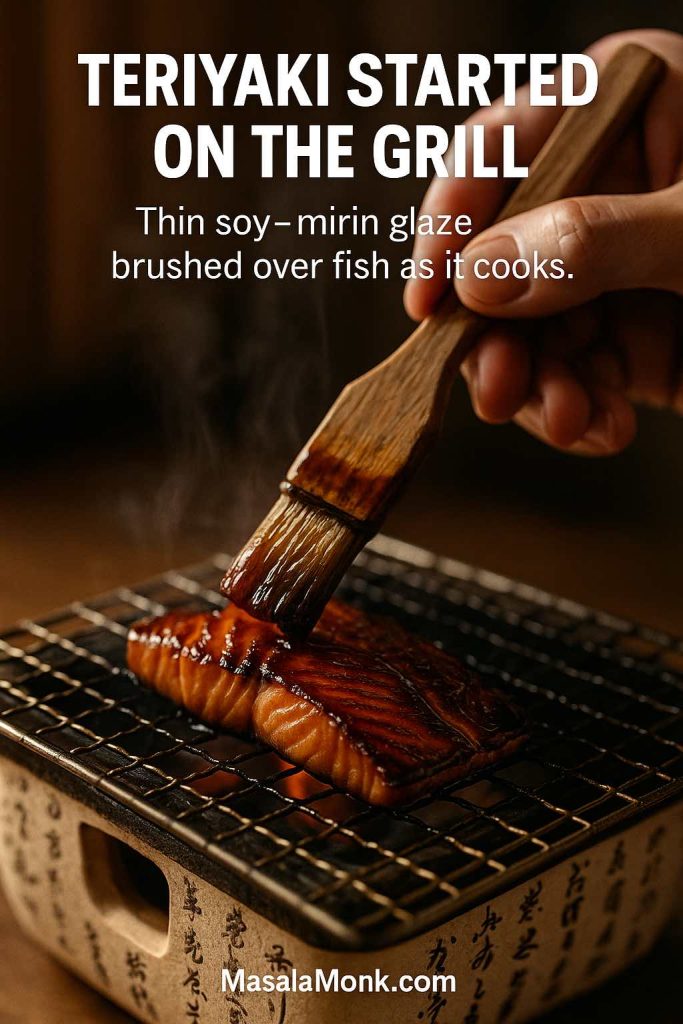
As Japanese cooks migrated and Japanese flavours spread, teriyaki began to adapt. In Hawaii, cooks folded in brown sugar and pineapple juice. In the US, garlic and ginger started appearing in the mix. Bottled teriyaki sauces appeared on shelves, often thickened with starch and stabilisers so they’d hold up over time. Restaurant dishes like chicken teriyaki bowls, beef teriyaki skewers and salmon teriyaki became staples.
So when someone says “teriyaki sauce” today, they might be thinking of:
- a light, traditional soy–mirin glaze
- a thick, sweet, garlicky bottled sauce
- or a homemade version that tries to be healthier, spicier or fruitier
Instead of treating those as completely separate things, it’s more helpful to see them as points on a spectrum, all built from the same core ingredients.
Also Read: Bolognese Sauce Recipe: Real Ragù & Easy Spag Bol
The Essential Building Blocks of Teriyaki
Every teriyaki sauce—whether it calls itself authentic, homemade, healthy, or “just like your favourite restaurant”—is some combination of a few key elements. Once you understand what each one does, creating your own version becomes much easier.
Soy Sauce: The Savoury Backbone of Any Teriyaki Sauce Recipe
The foundation of teriyaki is soy sauce. It brings salt, umami (that deep savoury dimension), and the dark, rich colour most people associate with the sauce.
The Wikipedia entry for soy sauce gives a good overview of how it’s traditionally brewed from soybeans, grain, water and salt. For our purposes, what matters is:
- regular soy sauce is intensely salty and savoury
- you can use low-sodium soy to make more forgiving sauces
- tamari, made mostly from soy without wheat, is a good choice when you need a gluten-free teriyaki base
Because soy sauce is so salty, it’s very easy for teriyaki to become sodium-heavy—especially when you reduce it into a sticky glaze. That’s why a lot of people look for lower sodium approaches, which we’ll come back to later.
Mirin and Sake: Shine and Sweetness
If soy sauce is the backbone, mirin is the soul of a traditional teriyaki. Mirin is a sweet rice wine used in Japanese cooking, described in more depth on pages like this mirin overview. It brings:
- natural sweetness
- a mild, wine-like aroma
- a helping hand with that glossy “teri” shine when it reduces with soy and sugar
Sake, another rice wine, sometimes joins the party, adding aroma and dimension. Put together, soy, mirin, sake and sugar form the base of the classic Japanese teriyaki glaze. No cornstarch, no garlic, no ginger—just those four building blocks simmered until they slightly thicken.
If you don’t have mirin, you can approximate it by combining a splash of sake or white wine with sugar, or by using sugar and rice vinegar together for a similar sweet-acid balance. It won’t be exact, but the overall character of the sauce will still lean toward teriyaki.
Sweeteners: Balance and Caramelisation in a Teriyaki Sauce Recipe
Teriyaki has a sweet side. That sweetness balances the saltiness of soy sauce and encourages the surface of the sauce to caramelise under high heat.
You can use:
- white sugar, for neutral sweetness
- brown sugar, for a deeper, caramel-like note
- honey, for a rounder, floral sweetness
Other sweeteners—maple syrup, coconut sugar, jaggery, date syrup—can slide in comfortably as well, depending on what you have and what kind of flavour you’re chasing.
The main thing is to remember that sugar is acting as a seasoning. It’s there to keep the sauce from tasting harsh and salty and to give it that repeat-able, “lick the spoon” quality. Take it too far and you end up with something that feels like dessert on your chicken; dial it in well and you get that classic sweet–savory balance.
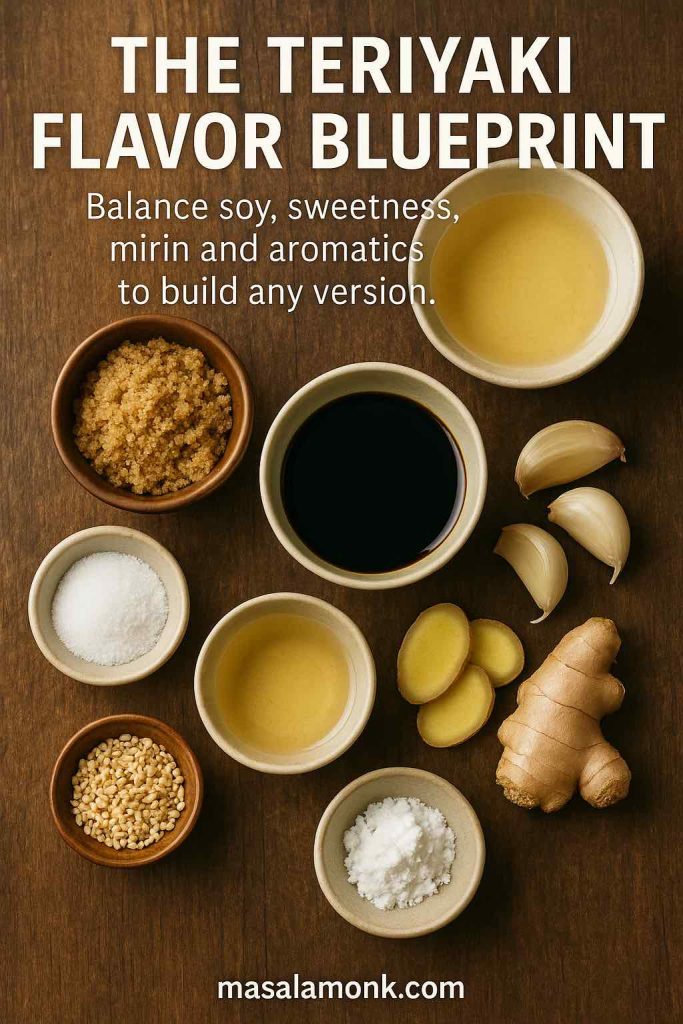
Garlic and Ginger: Aromatic Extras
In strictly traditional teriyaki, you can absolutely skip garlic and ginger. Many traditional Japanese teriyaki sauce recipes don’t include them. But they’ve become so common in global teriyaki that a lot of people instinctively expect that flavour.
Garlic adds a warm, pungent note; ginger brings a slightly spicy freshness. Together, they make the sauce:
- punchier and more aromatic
- better suited to stir-fries and noodle dishes
- closer to what most “teriyaki chicken” takeout tastes like
If you love ginger, you can double down and let the sauce lean into a ginger-forward profile. If you want something mellow, you can keep both garlic and ginger fairly subtle.
Thickening: Reduction, Starch or Syrup
Finally, there’s the question of texture. A teriyaki sauce recipe can be:
- thin and brushable
- thick and clingy
- or sticky and syrupy
There are three easy ways to get the texture you want.
Reduction
If you simmer a soy–mirin–sugar mixture gently, water evaporates and the sauce naturally thickens. This is how traditional teriyaki glaze is usually made: no extra thickener, just time and evaporation.
Starch slurry
Mix a spoonful of cornstarch with an equal or slightly larger amount of cold water until smooth, then stir that into a gently simmering sauce. As it heats, the starch thickens the liquid, giving you a glossy, reliable coating. This is what a lot of quick “homemade teriyaki sauce” recipes use.
Thicker sweeteners
Honey and syrupy sweeteners naturally give body. If your sauce includes them and you reduce it a bit, they help you get that sticky, almost lacquered consistency without needing much starch.
Once you’re familiar with these three levers, adjusting a sauce from “light glaze” to “thick stir-fry sauce” to “sticky wing glaze” becomes a simple question of preference.
Also Read: Authentic Chimichurri Recipe (Argentine Steak Sauce)
The Everyday Homemade Teriyaki Sauce Recipe
With the fundamentals in place, let’s actually make a sauce you can use on weeknights. This version keeps the ingredient list small, uses garlic and ginger, and relies on a cornstarch slurry so you get a consistent result even if you’re new to this.
It’s exactly the kind of thing you can batch once and then keep in the fridge, the way you might keep a jar of pesto or a homemade salad dressing.
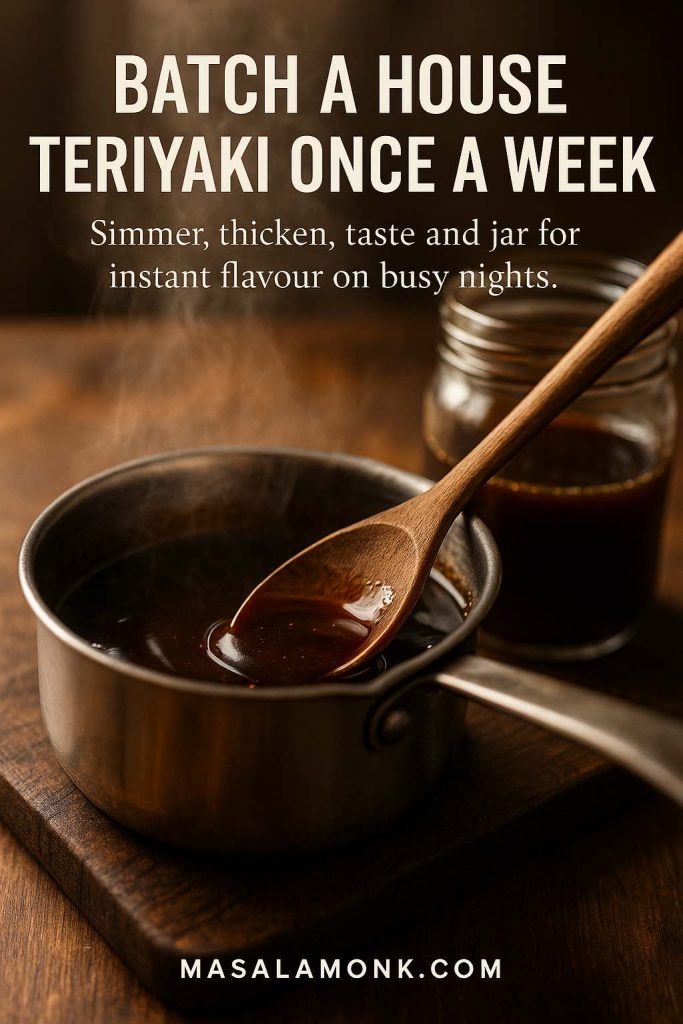
Ingredients for Teriyaki Sauce Recipe
- ½ cup soy sauce (regular or low-sodium)
- ½ cup water
- ¼ cup mirin (or 2 tablespoons mirin + 2 tablespoons sake if that’s what you have)
- ¼ cup brown sugar (you can replace part with honey for extra stickiness)
- 1–2 cloves garlic, very finely minced
- 1–2 teaspoons fresh ginger, grated
- 1 tablespoon rice vinegar (optional, for brightness)
- 1 tablespoon cornstarch
- 2 tablespoons cold water (for the slurry)
Step-by-Step Teriyaki Sauce Recipe
Step 1: Combine the base ingredients
Pour the soy sauce, water, mirin, brown sugar, garlic, ginger and rice vinegar into a small saucepan. Stir everything together so the sugar starts to dissolve and the garlic and ginger are evenly dispersed.

Step 2: Bring to a gentle simmer
Set the saucepan over medium heat. As it warms up, keep an eye on it and give it an occasional stir. Aim for a gentle simmer, not a furious boil. After a few minutes, the sugar will be fully dissolved and the kitchen will start to smell like teriyaki night.

Step 3: Make the cornstarch slurry
While the sauce is heating, mix the cornstarch and cold water in a small bowl until completely smooth. Any lumps now will turn into lumps in the sauce later, so it’s worth taking ten extra seconds to get this right.

Step 4: Thicken the sauce
Once the sauce is gently simmering, turn the heat down just a notch and slowly pour in the cornstarch slurry while stirring continuously. The liquid will look cloudy at first, then begin to clear and thicken. After a minute or two, it should coat the back of a spoon and fall in a slow, steady ribbon.
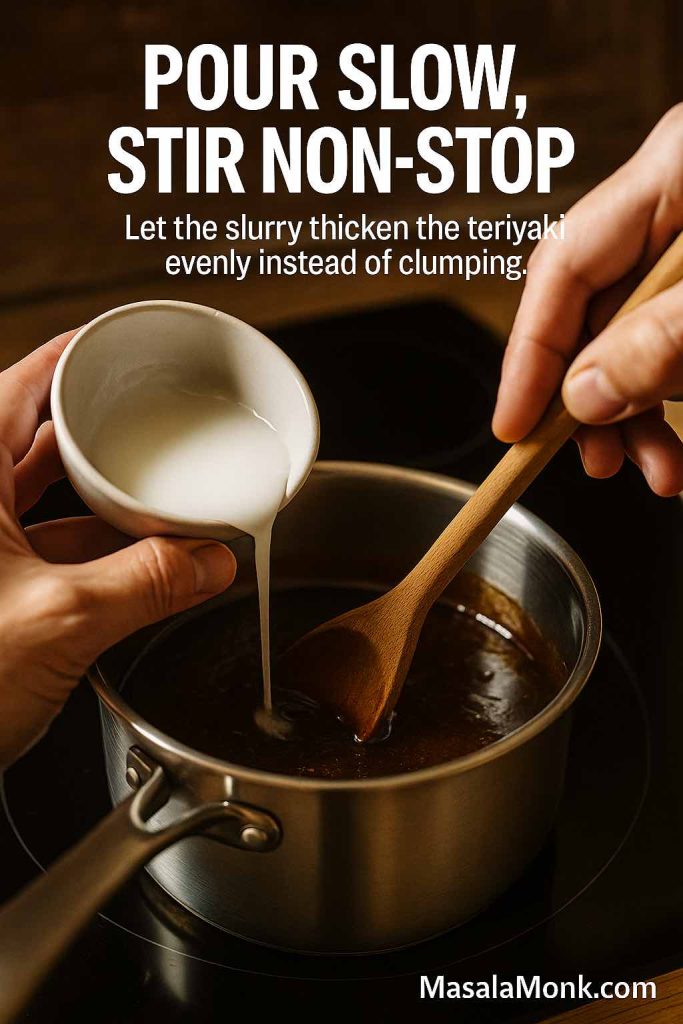
Step 5: Taste and adjust
Now taste the sauce.
If the sauce feels too salty, add a splash of water or a teaspoon more sugar.
If it tastes too sweet, add a dash more soy sauce or a little extra rice vinegar.
And if it seems a bit flat, another pinch of ginger often wakes everything up.

Step 6: Cool and store
When you’re happy with the flavour and texture, take the pan off the heat and let the sauce cool for a few minutes. It will thicken slightly as it stands. Pour it into a clean glass jar, let it come completely to room temperature, and then move it to the fridge.

Step 7: Use your house teriyaki sauce
Your house teriyaki sauce is ready. Brush it on grilled chicken, spoon it over salmon before baking, toss it with stir-fried vegetables and noodles, or reduce it a little further into a sticky glaze for wings or meatballs.
Also Read: Upma Recipe: 10+ Easy Variations (Rava, Millet, Oats, Semiya & More)

A More Traditional Japanese-Style Teriyaki Glaze Recipe
If you’re in the mood for something closer to what you might find in Japan—lighter, simpler, and without that cornstarch gloss—there’s an even more minimal version.
Here we go back to the roots: soy sauce, mirin, sake and sugar, simmered until glossy.
Ingredients
- ½ cup soy sauce
- ½ cup mirin
- ¼ cup sake
- 3–4 tablespoons sugar
Combine these in a small saucepan and stir until the sugar starts dissolving. Set the pan over medium heat and bring the mixture to a gentle simmer.
Keep it on that soft simmer for around 8–10 minutes, stirring occasionally, until the liquid has reduced by about a third. You don’t need to be exact here; what you’re looking for is a sauce that coats the back of a spoon in a thin, shiny layer, rather than running off like plain soy sauce.
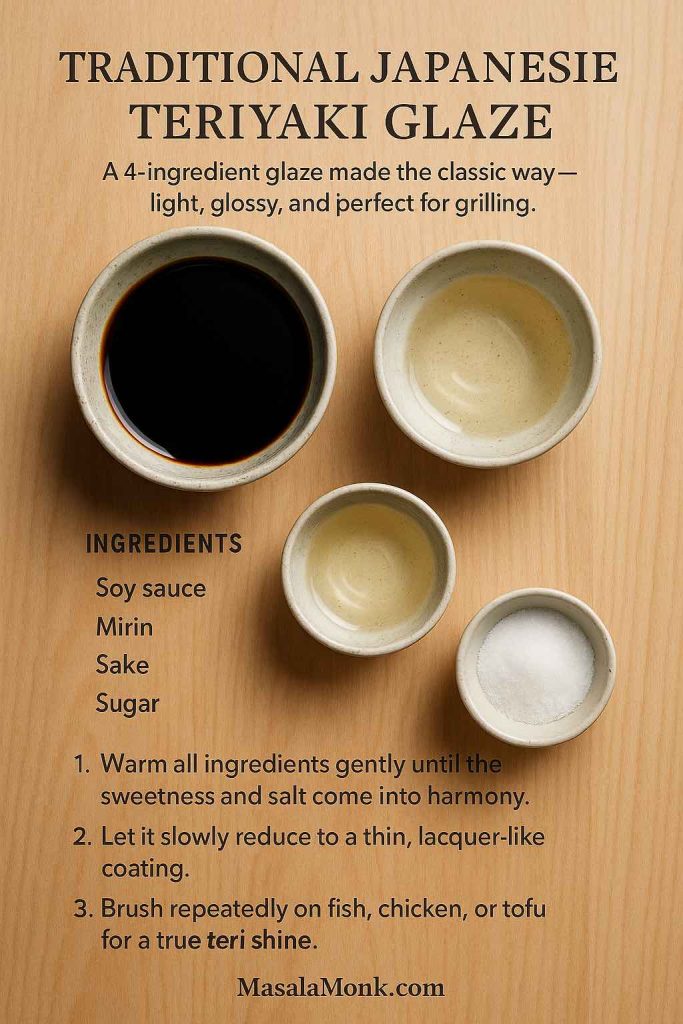
Take the pan off the heat and let it cool slightly. This is now your traditional-leaning teriyaki glaze.
Use it to brush repeatedly over pieces of chicken, fish or tofu while they grill or broil. The sugar and mirin will take on a deeper colour and the surface will go from matte to glossy. Each pass builds another layer of flavour.
This version is especially good on salmon and on chicken skewers, where you want the glaze to complement the grilled flavour rather than smother it.
Also Read: Double Chocolate Chip Cookies – Easy Recipe with 7 Variations
How One Sauce Becomes Many: Marinade, Stir-Fry, Glaze, Dip, Dressing
You don’t need completely different recipes for “teriyaki marinade”, “teriyaki glaze” and “teriyaki stir-fry sauce”. You just change the texture, strength and acidity in the original teriyaki sauce recipe.
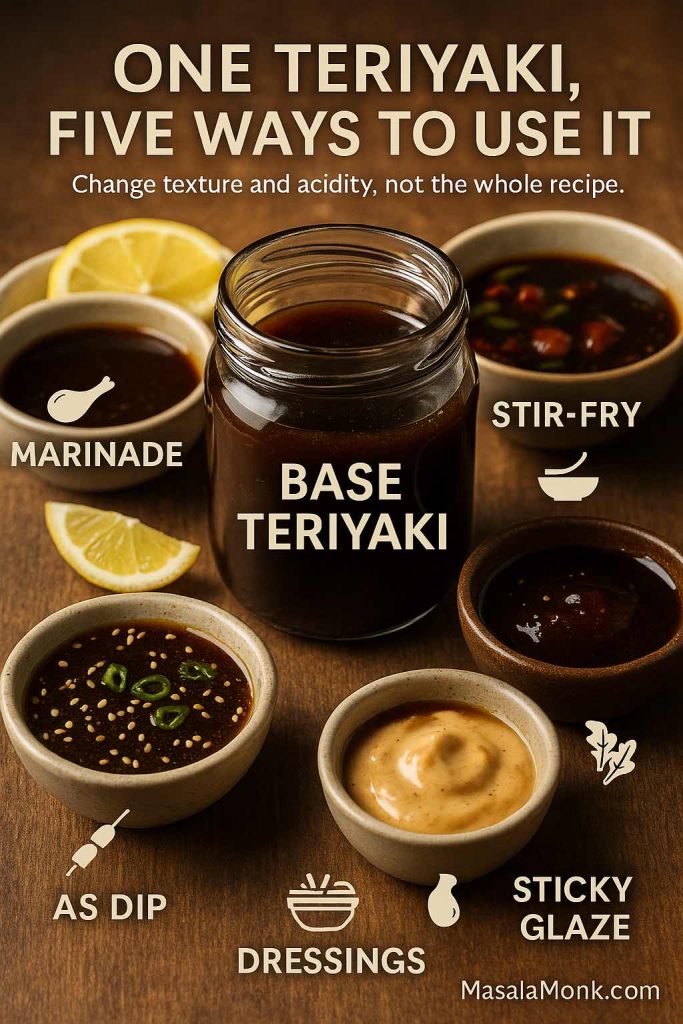
Turning It Into a Marinade
For marinating, you want the sauce thinner and usually a bit sharper. That way it coats the food easily and adds flavour without forming a heavy layer.
Take the everyday teriyaki (before thickening, or thinned slightly with water if it’s already thick) and add:
- a little extra rice vinegar, or
- a squeeze of lemon or lime

Pour this over chicken pieces, pork, tofu or sturdy vegetables and marinate in the fridge. Chicken thighs and drumsticks are happy with anywhere from half an hour to overnight. Fish does better with a shorter bath—twenty minutes to an hour—so it doesn’t go mushy. Tofu can handle long soaks, and often gets better with time.
If you want, you can boil the leftover marinade after you’ve removed the raw meat or fish and use it as a finishing sauce; just make sure it gets a good hard boil so it’s safe.
Using It as a Stir-Fry Sauce
In a stir-fry, you want the sauce to cling but still move. The cornstarch-thickened everyday teriyaki is perfect once you adjust its thickness.
If it’s too thick to pour smoothly, add a splash of water or unsalted stock. Then:
- Stir-fry your vegetables and protein over high heat.
- When everything is nearly done, reduce the heat slightly.
- Pour the teriyaki into the pan and toss quickly so it coats everything.

In a minute or two, the sauce will cling and glisten around the ingredients. Spoon this over hot rice, noodles or even quinoa. Set it next to other sharable sides—potato salads, dips, grilled vegetables—and it suddenly looks like a generous spread rather than “just a stir-fry”.
Reducing It to a Sticky Glaze
For wings, ribs, thick salmon fillets and roasted tofu cubes, you want a sauce that’s more like a glaze: sticky, intense and slightly caramelised.
You can either start with the everyday teriyaki and simmer it longer (with an extra spoonful of sugar or honey for extra sheen), or you can use the traditional soy–mirin–sake glaze and reduce it further.
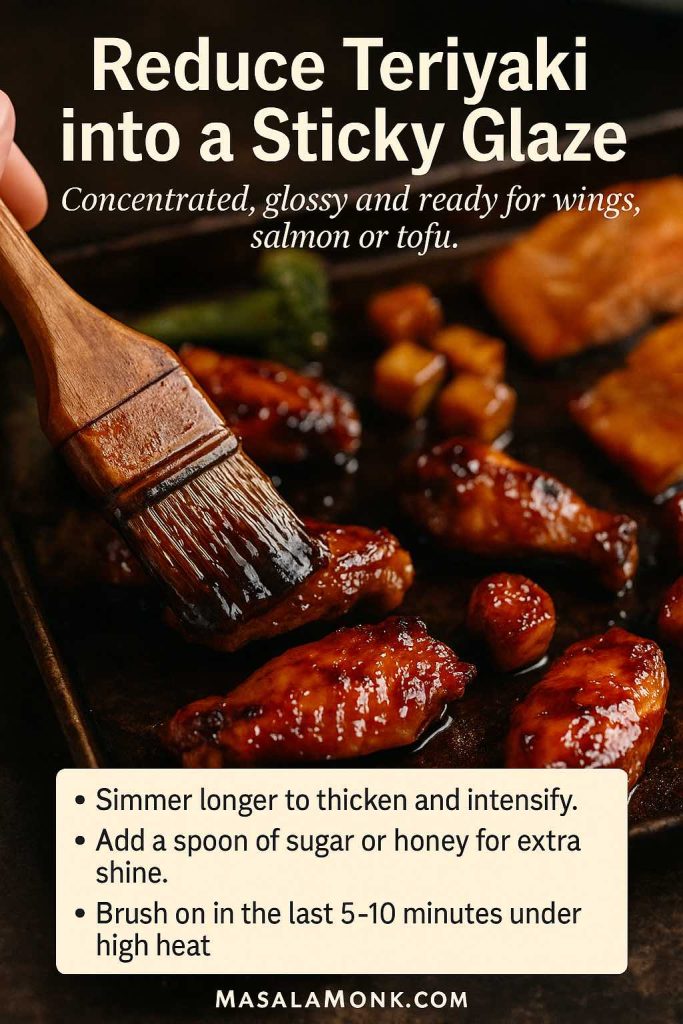
Brush thickened sauce onto food in the last stretch of cooking and let the oven or grill finish the job. If you want extra charring, give it a last-minute blast under a very hot broiler or grill, watching it closely so the sugar doesn’t burn.
Turning It Into a Dipping Sauce
Sometimes it’s nicer to dip than to coat. If you want teriyaki as a dip for dumplings, skewers, crispy tofu, roasted vegetables or even fries, you want a sauce that’s strong in flavour but thin enough to flow easily.
Take a portion of your homemade teriyaki and thin it with a little water or light stock. Add a bit more vinegar or citrus juice to brighten things and cut the sweetness. Pour into a small bowl and top with sesame seeds and chopped spring onion.
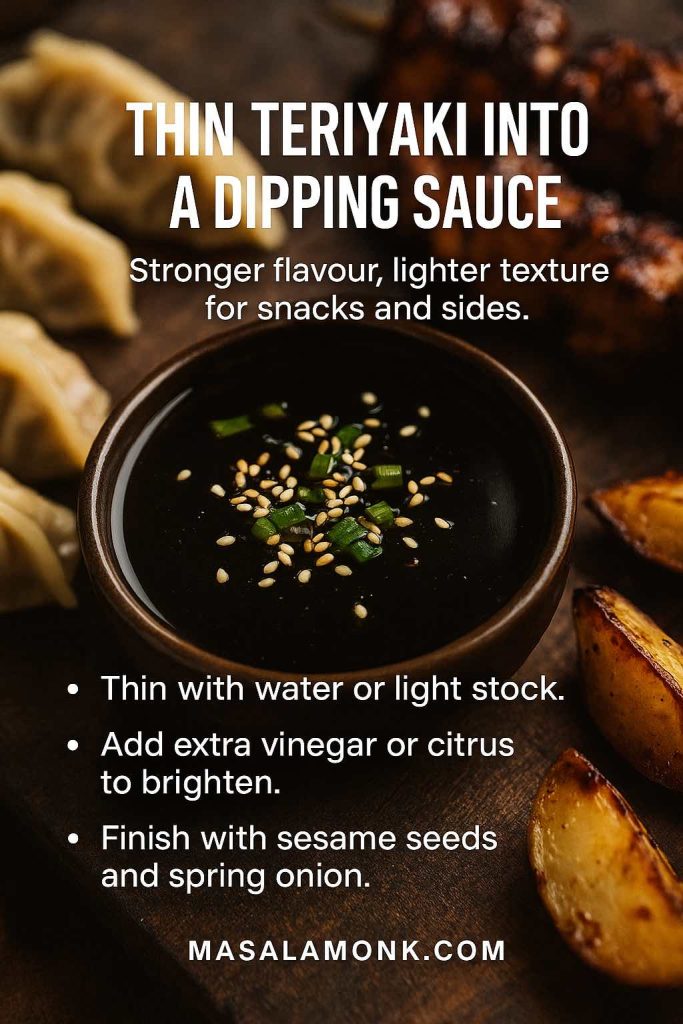
Put that on a table alongside other dips—spinach-based ones, creamy spreads, spicy options—and suddenly teriyaki is playing in the same space as buffalo sauce and ranch, not just “stir-fry sauce”.
Using It as a Dressing or Mayo
Teriyaki also works beautifully off the heat.
For a simple dressing, whisk equal parts teriyaki sauce and neutral oil together, then add a spoon of rice vinegar or lemon juice. You get a punchy salad dressing that loves green salads, grain bowls and noodle salads. Shake it in a jar until lightly emulsified, then toss or drizzle as you like.

For a sandwich or burger sauce, stir a spoonful or two of teriyaki into mayonnaise and taste as you go. That simple mix is surprisingly good on chicken sandwiches, burgers, sliders and teriyaki-style rice bowls. If you like building stacked sandwiches with layers of texture and flavour, you can borrow structure ideas from MasalaMonk’s own chicken sandwich recipe collection and simply swap their sauce element for your teriyaki mayo.
Also Read: One-Pot Chicken Bacon Ranch Pasta (Easy & Creamy Recipe)
Playing with Flavours: Honey, Citrus, Pineapple, Miso, Spice
Once the base is second nature, you can adjust it to suit your mood or the rest of the menu. Most “special” teriyaki sauce recipes are just small nudges away from that everyday sauce.
Honey Teriyaki Sauce Recipe
Replacing some or all of the brown sugar with honey gives you a honey-teriyaki hybrid. Honey makes the sauce silkier and helps it cling to food in a particularly satisfying way.

This version is perfect for:
- chicken wings and drumsticks
- sticky meatballs
- glossy tofu bites
Just remember that honey browns faster than regular sugar, so keep an eye on oven and grill temperatures to avoid scorching.
Recipe for Ginger-Sesame Teriyaki Sauce
If ginger is your favourite part, double the amount you add and keep the garlic modest in the original teriyaki sauce recipe. When the cooking is done, stir in a teaspoon of toasted sesame oil and a spoonful of toasted sesame seeds.
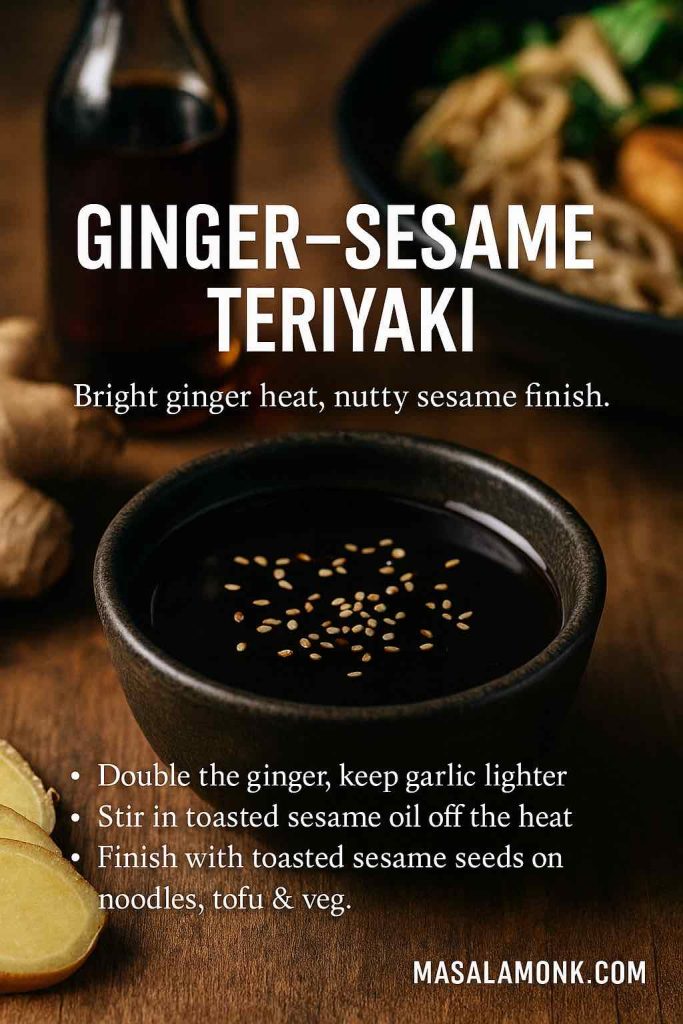
What you get is a sesame–ginger teriyaki that’s ideal for:
- tofu and vegetable stir-fries
- soba and udon noodle bowls
- roasted or steamed greens
It’s also a great way to make cold noodle salads feel complete without loading them up with mayonnaise.
Orange Teriyaki Sauce Recipe
To bring citrus into the picture, swap part of the water in the base recipe for fresh orange juice and add grated orange zest at the end. Taste the result and adjust with extra soy or vinegar if it leans too sweet.

Orange teriyaki sits beautifully on:
- chicken stir-fries with bell peppers
- shrimp or prawn skewers
- fusion dishes like teriyaki chicken pizza
It’s especially useful when you want something that feels lighter and fresher than a straight soy-based glaze.
Recipe of Pineapple Teriyaki Sauce
For a more tropical character, use pineapple juice in place of some of the water and sugar. Pineapple’s natural enzymes can help tenderise meat, which is why pineapple-based marinades are so common in grill cultures.
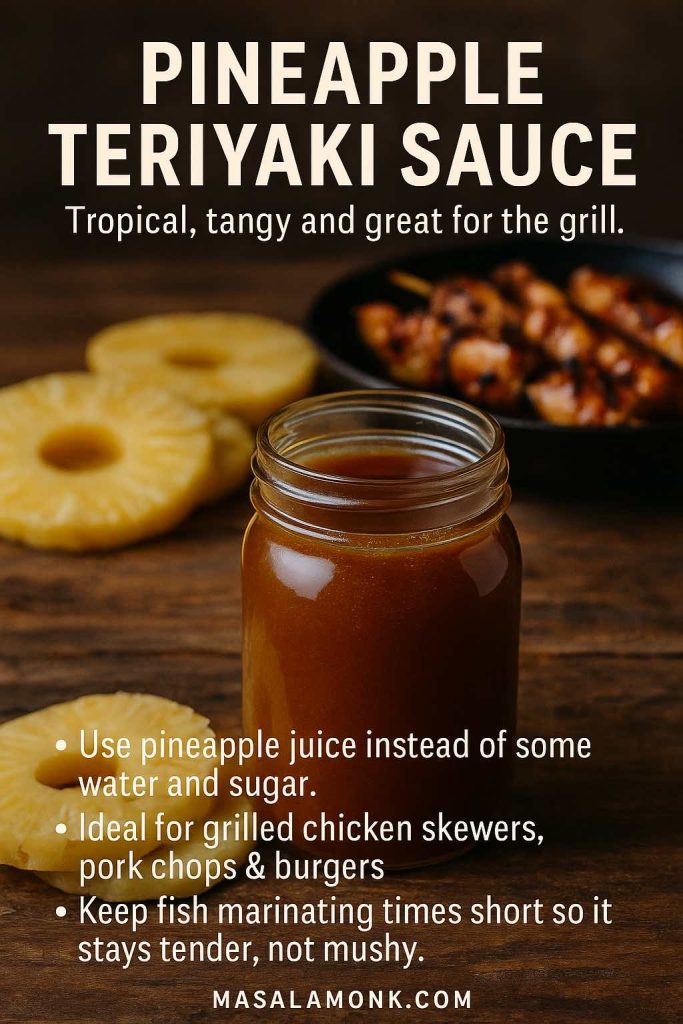
Use homemade pineapple teriyaki sauce on:
- grilled chicken skewers
- pork chops and pork tenderloin
- burgers topped with grilled pineapple rings
Just go easy with marinating delicate fish in pineapple heavy mixtures for long periods; shorter times work better to preserve texture.
Apple-Lifted Teriyaki Sauce Recipe
Apple juice and a spoon of applesauce can soften teriyaki’s edges and give it a mild, autumnal feel. A pinch of cinnamon or nutmeg can tilt it gently toward “warm spice” without turning it into dessert.
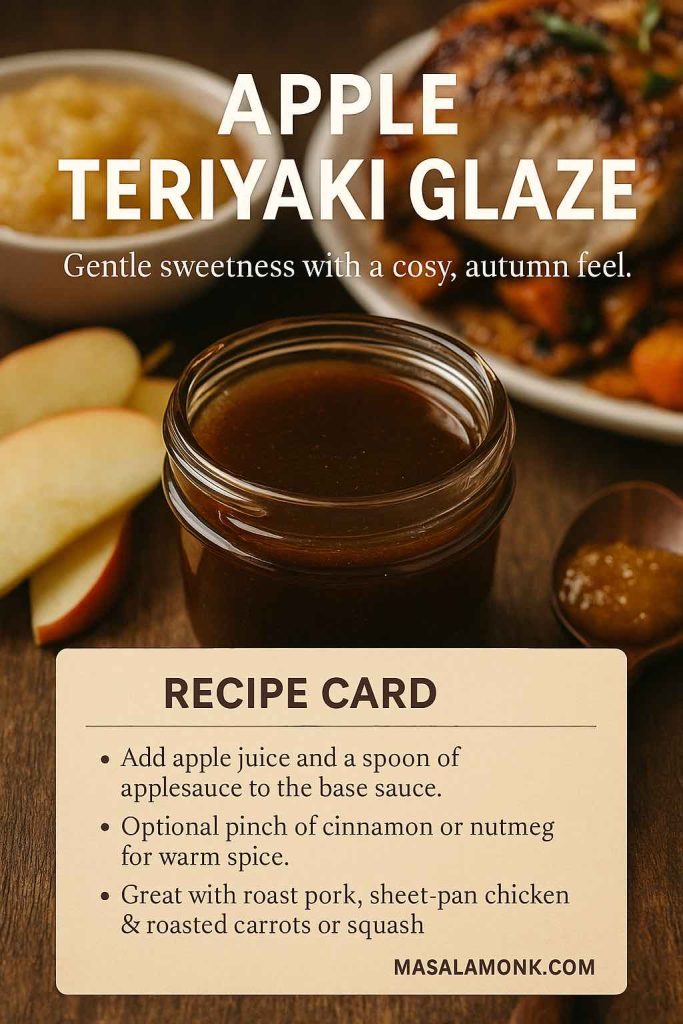
This style of sauce suits roast pork, sheet-pan chicken dinners with onions and apples, and roasted carrots or squash.
Miso Teriyaki Sauce & Its Recipe
Miso is another fermentation star in Japanese cooking, and adding a spoon of miso paste to warm teriyaki sauce deepens its savoury side.
Take the pan off the heat, whisk in a spoon of white or red miso, and taste. You might not need more soy after that; miso is salty as well.
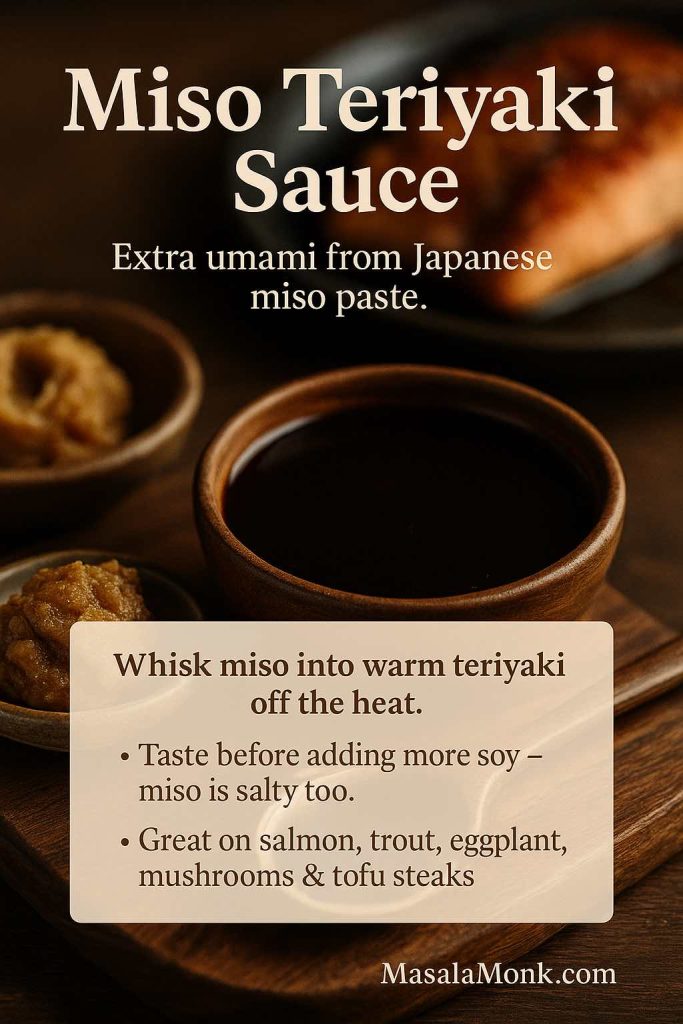
Miso teriyaki is particularly good on:
- salmon or trout
- eggplant, mushrooms and other umami-friendly vegetables
- tofu steaks and skewers
It feels simple but layered, which is exactly what you want when the sauce is doing most of the work.
Spicy Teriyaki Sauce Recipe
For those nights when you want a little heat, add sriracha, gochujang or your favourite chilli paste to the simmering sauce. Start with a teaspoon or two, taste, and adjust. You can also finish with a squeeze of lime juice if you like spice plus tang.
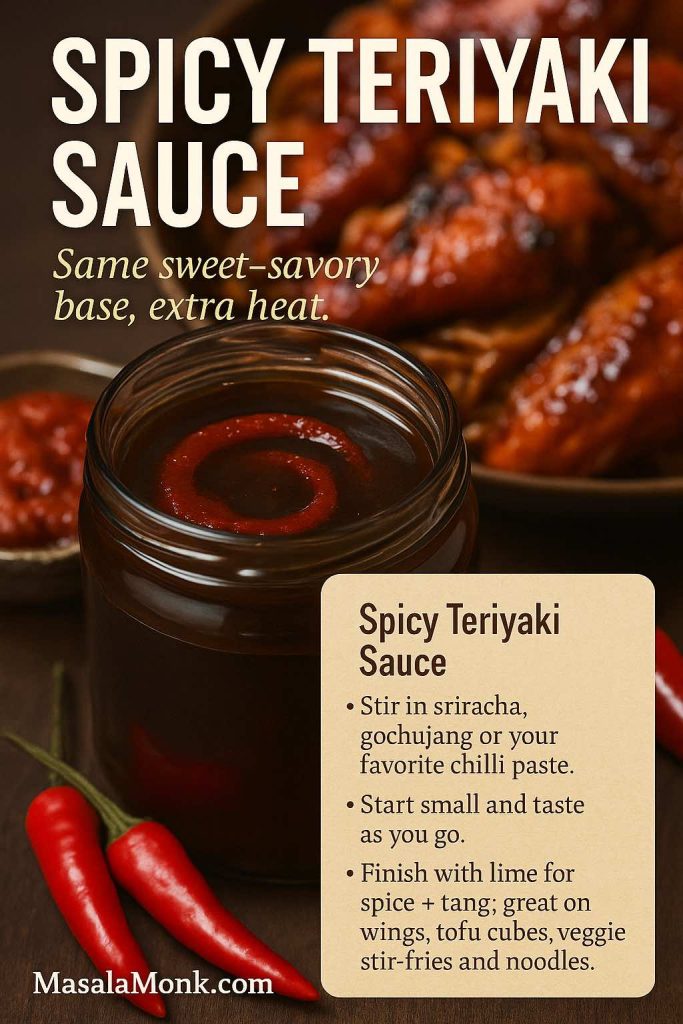
Spicy teriyaki is ideal for:
- hot wings
- sticky tofu cubes
- vegetable stir-fries
- noodle dishes with a bit of a kick
It sits comfortably on a table with buffalo wings, creamy dips and crisp salads, especially if you like building mixed, “everyone grabs what they like” spreads.
Also Read: Authentic Louisiana Red Beans and Rice Recipe (Best Ever)
Making Teriyaki Friendlier: Less Sugar, Less Salt, Keto, Vegan, Soy-Free
Because teriyaki is built on soy sauce and sugar, it doesn’t automatically fit every eating style. But once you’re making it at home instead of relying solely on bottled versions, you have a lot more control.
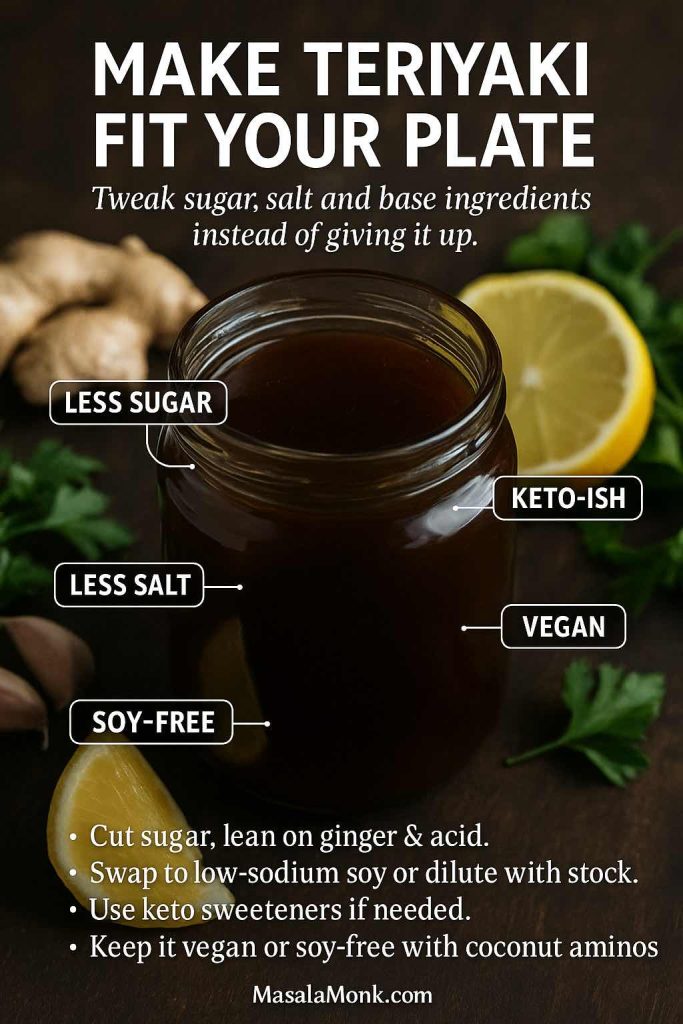
Cutting Back on Sugar in the Recipe for Teriyaki Sauce
You can usually cut the sugar in a teriyaki recipe by a third or even half without destroying the balance, especially if you:
- keep mirin in the mix
- lean more on ginger and garlic
- let a bit more acidity (vinegar or citrus) balance the salt
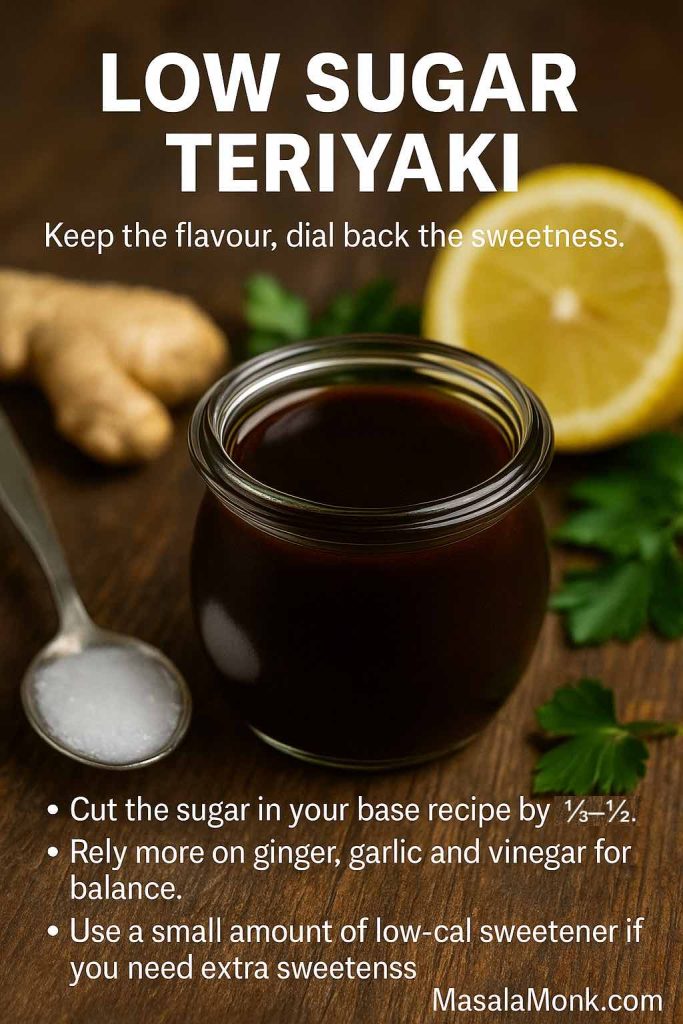
For more aggressive sugar reduction, you can substitute part of the sugar with low-calorie sweeteners. Just be careful with reductions: without sugar to round things out, very reduced sauces can taste sharply salty.
Making It More Keto-Friendly
For a keto-leaning teriyaki sauce recipe, you want lower net carbs:
- use low-sodium soy or tamari, diluted with water
- sweeten with a keto-compatible sweetener
- thicken with a tiny pinch of xanthan gum if you need a glaze, or leave it thinner
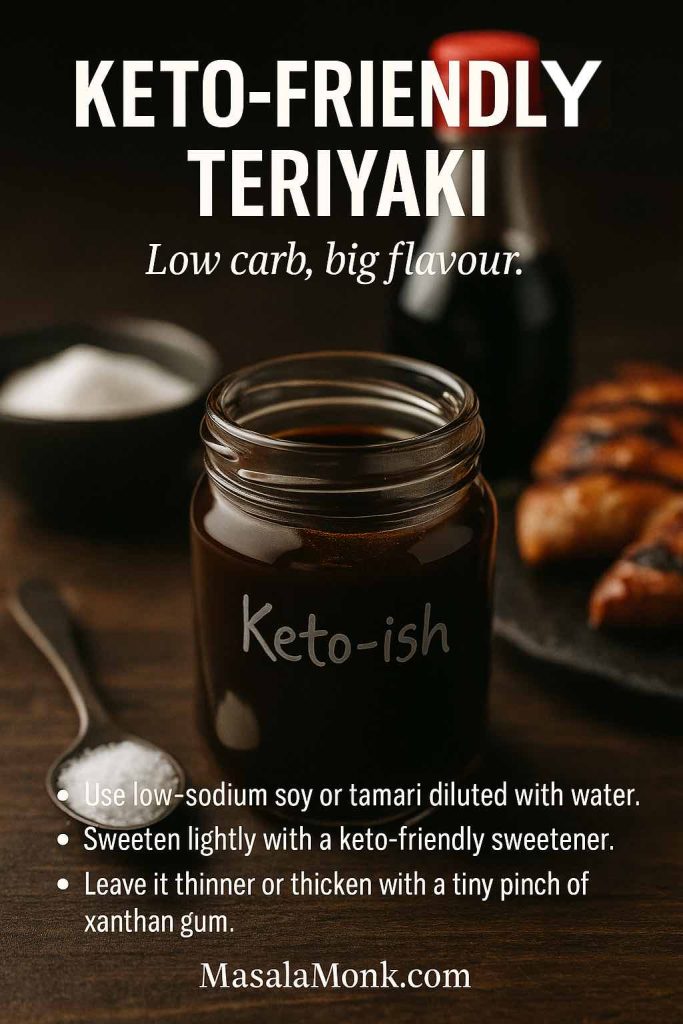
In practice, you’ll probably use less sauce per serving and let the grilled meat, fish or tofu do more of the talking.
Lowering the Sodium Load in Teriyaki Sauce Recipe
Salt is the other big issue. It doesn’t take much teriyaki sauce to push your sodium intake up for the day, and most health guidelines suggest keeping sodium on the conservative side for heart and kidney health.
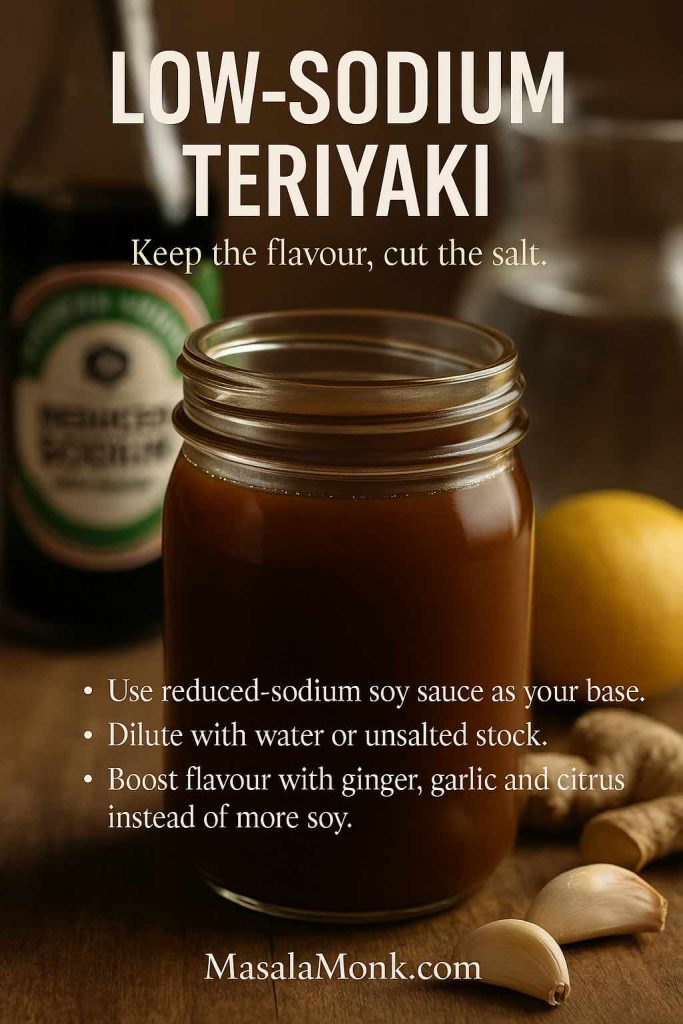
Instead of just accepting that, you can:
- base your sauce on reduced-sodium soy sauce
- dilute soy with water or unsalted stock
- build flavour with ginger, garlic, chilli and acid instead of extra soy
You’ll still get plenty of teriyaki character, but with a much softer impact on your daily salt tally.
Keeping Your Teriyaki Sauce Recipe Vegan
Most homemade teriyaki sauces are almost vegan by default. As long as you skip honey and stick to sugar or maple syrup, the standard soy–mirin–garlic–ginger mixture is plant-based.
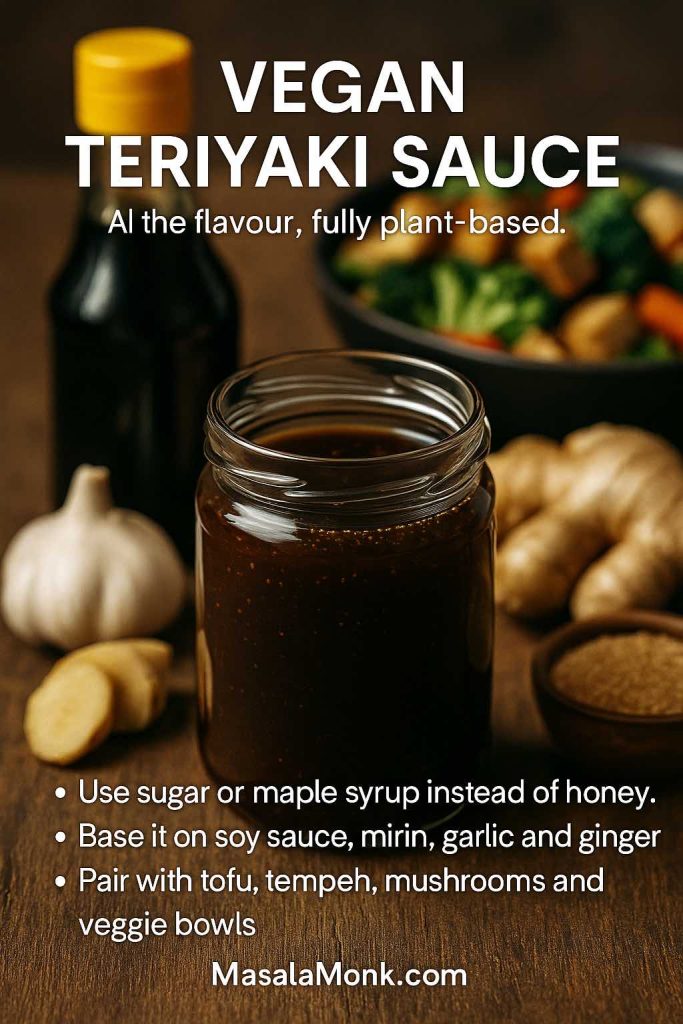
Combine that with tofu, tempeh, mushrooms, seitan or beans and you have endless vegan teriyaki bowls and plates. You can structure them the way you’d structure high-protein salads or spreads—like the ones in MasalaMonk’s healthy tuna salad ideas—but swap the tuna for chickpeas or lentils and the mayo for teriyaki.
Going Soy-Free with Coconut Aminos
If you need to avoid soy, coconut aminos is your friend. It’s made from fermented coconut sap and salt, and while it tastes different from soy sauce, it still brings a dark, savoury note. It’s also generally lower in sodium and naturally gluten- and soy-free.
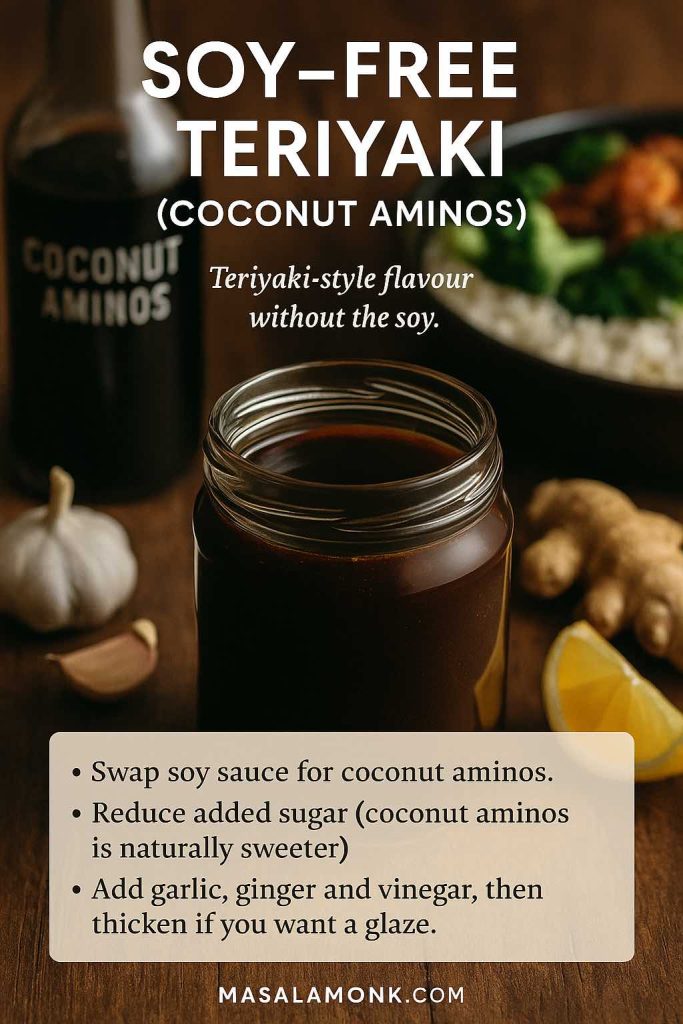
To modify the recipe and make a soy-free teriyaki-style sauce:
- use coconut aminos instead of soy sauce
- reduce or omit extra sugar (coconut aminos is sweeter than soy)
- add garlic, ginger and vinegar
- reduce or lightly thicken with starch if you want a glaze
It won’t taste exactly like traditional teriyaki, but it’s recognisably in the same family and plays the same role on the plate.
Also Read: Sheet Pan Chicken Fajitas Recipe (Easy One-Pan Oven Fajitas)
Bottled Teriyaki vs Homemade: Which Has the Edge?
Bottled teriyaki has one unbeatable strength: convenience. You finish work, you’re tired, you don’t feel like measuring anything, and that bottle is right there. Pour some over chicken or vegetables, and you’re halfway to dinner.
The tradeoffs are just as clear:
- you don’t control how salty or sweet it is
- you’re stuck with the brand’s idea of texture and flavour balance
- you often get stabilisers and preservatives you probably don’t need in a fresh sauce

A homemade teriyaki sauce recipe asks for a little more effort once, then repays you many times. There’s no single “best teriyaki sauce recipe” for everyone, but when you make it yourself you can dial in your own best version. You:
- decide how salty, sweet and thick it should be
- can tune it to your household’s tastes (more ginger, less garlic, citrusy, smoky, etc.)
- can adapt it to different needs (lighter one night, sticky the next)
That does not mean you don’t have to throw away bottled sauce forever. You can also treat it as a base ingredient. Sauté garlic and ginger, add bottled teriyaki and cook it for a few minutes; thin or reduce as needed; finish with citrus, honey, chilli or miso. That’s the same philosophy MasalaMonk uses in things like their homemade coffee creamer flavour guide: start with something simple, then bend it to your will.
But if you take one thing away from this post, let it be this: the jump from “I buy teriyaki” to “I make teriyaki” is smaller than it looks.
Also Read: Cheesy Chicken Broccoli Rice – 4 Ways Recipe (One Pot, Casserole, Crockpot & Instant Pot)
Quick Teriyaki Chicken Recipe (Using This Sauce)
If you only make one dish with this teriyaki sauce recipe, let it be simple chicken teriyaki – the kind of easy teriyaki chicken recipe (stovetop, air fryer or oven) you can throw together on a weeknight. It’s the kind of weeknight meal that tastes like takeout, uses just one pan, and works with chicken thighs or breast.
Ingredients
- 500–700 g chicken thighs or breast, cut into bite-sized pieces
- 2 tablespoons neutral oil
- Salt and pepper (just a pinch; the sauce is salty)
- ½ to ¾ cup homemade teriyaki sauce (from the everyday teriyaki sauce recipe above)
- Cooked white rice or brown rice, to serve
- Steamed or stir-fried vegetables (broccoli, carrots, peppers, beans), to serve

How to Cook Teriyaki Chicken
- Prep the chicken. Pat the chicken dry and season very lightly with salt and pepper.
- Sear. Heat the oil in a wide pan over medium-high heat. Add the chicken in a single layer and cook until lightly browned on both sides and just cooked through.
- Add the teriyaki sauce. Reduce the heat to medium, pour in the teriyaki sauce and toss so every piece is coated.
- Glaze. Let the sauce bubble gently for a few minutes, stirring, until it thickens into a shiny glaze and clings to the chicken. If it gets too thick, add a splash of water; if it’s too thin, simmer for another minute.
- Serve. Spoon the chicken teriyaki over hot rice with plenty of vegetables on the side. Drizzle over any extra sauce from the pan.
This basic chicken teriyaki recipe is easy to spin into variations. Toss cooked noodles through the pan for chicken teriyaki noodle stir fry, or pile the glazed pieces into a bun with crunchy salad for teriyaki chicken burgers.
Also Read: Whiskey Sour Recipe: Classic Cocktail, Best Whiskey & Easy Twists
Easy Teriyaki Salmon Recipe
For salmon teriyaki, the oven does most of the work. This is a simple teriyaki salmon recipe that uses the same everyday sauce.
- Heat the oven to 200°C. Line a baking tray with parchment.
- Place 4 salmon fillets on the tray, skin-side down. Pat dry and season very lightly with salt and pepper.
- Spoon a generous layer of teriyaki sauce over each fillet.
- Bake for 10–12 minutes, depending on thickness, until the salmon is just cooked through.
- For a more caramelised finish, brush with a little more sauce and give the fillets 1–2 minutes under a hot grill or broiler.
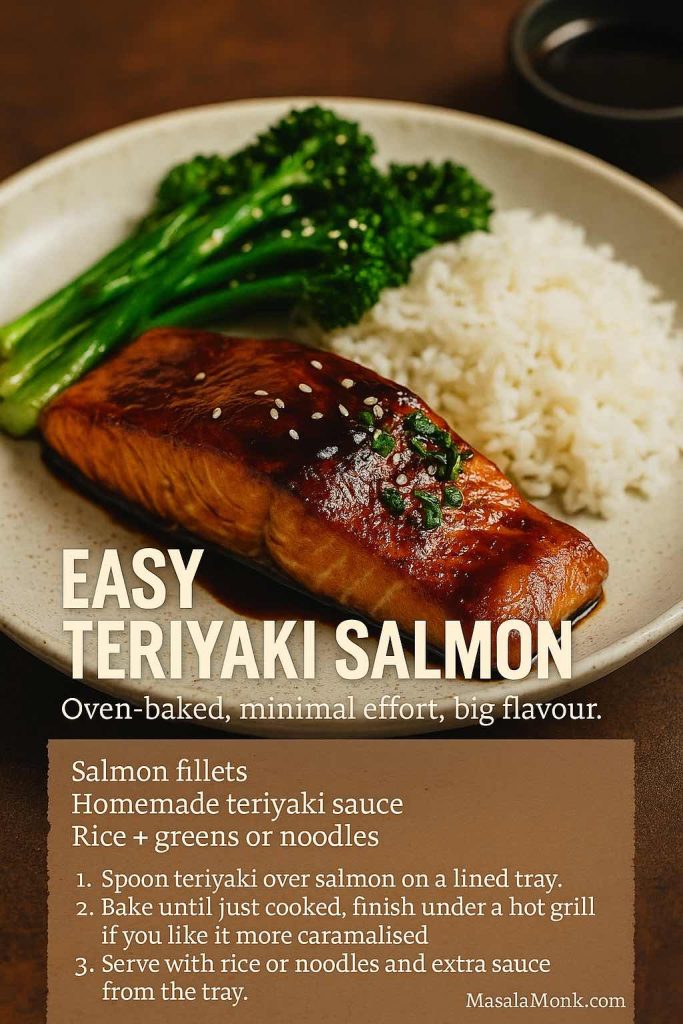
Serve the baked teriyaki salmon with rice and vegetables, or flake it over warm noodle bowls. The same method works for other firm fish fillets if you’re in the mood for fish teriyaki beyond salmon.
Also Read: Easy Lemon Pepper Chicken Wings (Air Fryer, Oven & Fried Recipe)
Simple Beef Teriyaki Stir-Fry (with rice or noodles)
Beef teriyaki is another fast, high-heat favourite. Thin slices of beef cook in minutes and soak up the teriyaki stir-fry sauce beautifully.
- 300–400 g beef steak, sliced thinly against the grain
- 2 cups mixed vegetables (broccoli, carrots, peppers, snap peas)
- 2 tablespoons neutral oil
- ½ cup teriyaki sauce, thinned with a splash of water if very thick
- Cooked rice or noodles, to serve
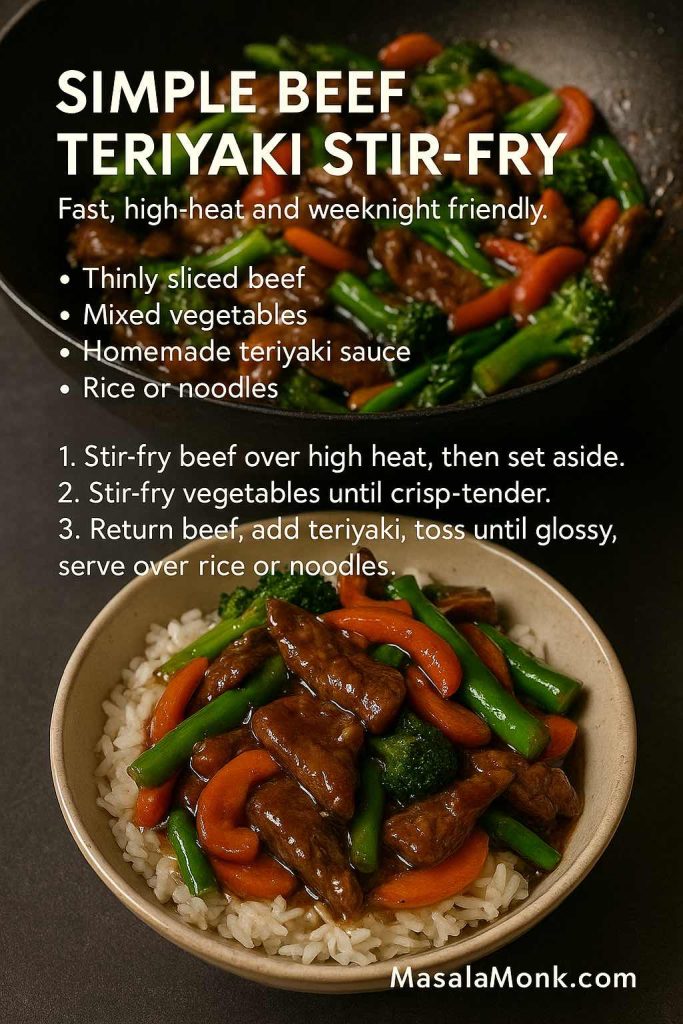
- Stir-fry the beef. Heat 1 tablespoon oil in a hot pan or wok. Add the beef and stir-fry just until browned; remove to a plate.
- Cook the vegetables. Add the remaining oil and the vegetables. Stir-fry over high heat until crisp-tender.
- Combine with sauce. Return the beef to the pan, pour in the teriyaki sauce and toss everything together. Cook for 1–2 minutes until the sauce bubbles and coats the beef and vegetables.
- Serve. Spoon your beef teriyaki stir-fry over rice, or toss with cooked noodles for beef teriyaki noodles.
This one pan teriyaki beef and rice or noodle dinner is an easy way to turn the same teriyaki sauce recipe into a new meal.
Also Read: Crispy Homemade French Fries From Fresh Potatoes (Recipe Plus Variations)
Bringing It All Together in Real Meals
Theory is nice, but you’re going to remember teriyaki by what you put on the table.
You might start by whisking up that everyday teriyaki sauce, then:
- marinate chicken thighs in a thinner, more acidic version and roast them on a tray with onions and peppers, brushing with a thicker glaze in the last ten minutes
- spoon the traditional soy–mirin–sake glaze over salmon fillets as they grill, letting it build up into a shiny layer, then serve them with rice and a crisp side from the potato salad recipes you’ve bookmarked
- throw together a fridge-cleanout stir-fry with vegetables, tofu and a ladle of teriyaki, knowing you can adjust sweetness and salt right there in the pan
- build warm or cold noodle bowls with soba, plenty of vegetables and a ginger-sesame teriyaki dressing
- glaze pork chops or pork tenderloin with pineapple teriyaki and serve with a simple salad and grilled pineapple slices
- spread pineapple-lifted teriyaki over a pizza base, add leftover chicken teriyaki and bake for an easy teriyaki chicken pizza night.

If you’re hosting, you can lean harder into variety. Make a platter of wings: some in honey teriyaki, some in spicy teriyaki. Put out bowls of dips—spinach dip, buffalo chicken dip, hummus—along with raw vegetables, bread and crackers. Pour drinks, maybe even something fun and fizzy from a set of mimosa ideas, and suddenly your weeknight sauce has turned into a party.
Also Read: Katsu Curry Rice (Japanese Recipe, with Chicken Cutlet)
Conclusion
Over time, you’ll find your own sweet spot: maybe a slightly less sweet, more gingery version for everyday cooking; a fruit-heavy pineapple or orange teriyaki for grilling; a miso-enriched glaze for salmon; and a low-sugar, low-sodium version when you want to keep things light but flavourful.
And at that point, “teriyaki sauce” isn’t a mysterious thing in a bottle anymore. It’s just one of your house sauces—like pesto, like chimichurri, like tzatziki—waiting in the fridge or on the stove, ready to make simple food feel like something worth sitting down for.
FAQs on Teriyaki Sauce and its Recipe
1. What is teriyaki sauce, exactly?
Teriyaki sauce is a sweet–savory Japanese-style sauce built on soy sauce, a sweetener (usually sugar or honey), and mirin or another mild cooking wine. Traditionally, it began as a glaze brushed over grilled fish or chicken, giving the surface a shiny, caramelised coating. Over time, it has evolved into a multi-use sauce for marinating, stir-frying, glazing, dipping, and even dressing salads and noodle bowls.
2. How do you make a simple homemade teriyaki sauce from scratch?
To begin with, you only need a few pantry staples. Combine soy sauce, water, mirin (or a mix of mild wine and sugar), brown sugar, minced garlic, grated ginger, and a splash of rice vinegar in a saucepan. Simmer gently until the sugar dissolves and the flavours mingle. Then, if you want it thicker, stir in a cornstarch-and-water slurry and cook for a minute or two until glossy. Taste, adjust sweetness and salt, cool it, and your homemade teriyaki sauce is ready to use or store for quick teriyaki chicken, salmon, beef or veggie stir-fries.
3. What’s the difference between authentic Japanese teriyaki and the thicker takeout-style sauce?
In authentic Japanese teriyaki, the sauce is usually just soy sauce, mirin, sake, and sugar simmered until slightly syrupy, with no garlic, no ginger, and no cornstarch. It stays light and clean, meant mainly for brushing over grilled fish or chicken. By contrast, many takeout-style or bottled teriyaki sauces are thicker, sweeter, and heavily scented with garlic and ginger, often relying on starch for that shiny, clingy texture. Both are delicious, but they serve slightly different purposes in cooking.
4. What ingredients do I really need for teriyaki sauce if my pantry is basic?
Even with a minimal pantry, you can still make a good teriyaki-style sauce. At the very least, you need soy sauce for salt and umami, sugar (or honey) for sweetness, and water to keep it from being overpowering. Whenever possible, adding something mirin-like (or a mild wine plus sugar), along with a little garlic and ginger, makes the flavour much more rounded. From there, extras like rice vinegar, sesame oil, or chilli are optional upgrades, not requirements.
5. How can I make my teriyaki sauce thicker and stickier?
If your teriyaki sauce feels too thin, there are several ways to change that. The most straightforward method is to simmer it for longer so water evaporates and the sauce naturally reduces and thickens. Alternatively, you can whisk a small amount of cornstarch into cold water, then stir this slurry into gently simmering sauce until it becomes glossy and coats the back of a spoon. For an even stickier glaze, increasing honey or another syrupy sweetener and cooking for a little longer works beautifully on wings, drumsticks, salmon and tofu.
6. Can I make teriyaki sauce without mirin or sake?
Yes, you absolutely can. When mirin or sake isn’t available, you can still get very close to that classic taste. One approach is to use a mild white wine with a little extra sugar. Another option is to mix sugar with a bit of rice vinegar and water to mimic some of mirin’s sweet–tangy balance. It won’t be perfectly traditional, yet the resulting sauce will still taste recognisably like teriyaki and work well in marinades, stir-fries and glazes.
7. Is teriyaki sauce healthy, and how can I make it lighter?
On its own, teriyaki sauce tends to be high in sodium and contains added sugar, so it’s more of a “use thoughtfully” ingredient than a neutral one. However, it can absolutely fit into a balanced way of eating. To make it lighter, you can switch to low-sodium soy sauce, dilute the soy with water, and reduce the sugar by a third to half. In addition, leaning more on ginger, garlic and a touch of vinegar keeps the flavour big while toning down the salt and sweetness. Using less sauce per serving and pairing it with plenty of vegetables also helps.
8. How do I turn teriyaki sauce into a marinade, stir-fry sauce, or dipping sauce?
Interestingly, you don’t need separate recipes for each use. For a teriyaki marinade, simply keep the sauce thinner and slightly more acidic by adding a bit more water and vinegar or citrus. Then for a stir-fry sauce, aim for medium thickness so it coats ingredients without turning gloopy—your cornstarch-thickened version is ideal here. And for a dipping sauce, thin a small amount with water or light stock, then brighten it with extra vinegar or lime so it’s punchy, pourable and perfect alongside dumplings, skewers, tofu or roasted vegetables.
9. How long does homemade teriyaki sauce last in the fridge?
Generally, homemade teriyaki sauce keeps well in a sealed jar in the refrigerator for about one week, sometimes a bit longer if it’s cooked, cooled and stored cleanly. Because it contains soy and sugar, it has some built-in preservative qualities, but it still counts as a fresh sauce. Before using leftovers, give it a sniff, a quick look and a small taste. If anything seems off—odd smell, separation that doesn’t mix back, or mould—discard it and make a fresh batch.
10. Can I freeze teriyaki sauce for later?
Absolutely. Moreover, freezing is a smart way to batch-prep. Once your teriyaki sauce has cooled completely, pour it into freezer-safe containers or small portions in ice cube trays. When frozen, you can pop the cubes into a bag for easy storage. On busy days, just thaw a few cubes in a saucepan or microwave and use them as a glaze, marinade base or stir-fry sauce. This trick also lets you make different versions—honey, ginger-heavy, spicy—and keep them ready to go.
11. How do I make a low sugar or keto-friendly teriyaki sauce?
For a lower sugar teriyaki, start by cutting the sugar in your favourite recipe in half and letting mirin, ginger, garlic and vinegar do more of the flavour work. If you’d like to go further and keep the sauce very low in carbohydrates, you can use a sugar substitute that behaves well in cooking, then taste and adjust carefully to avoid an artificial aftertaste. In addition, keeping the sauce slightly thinner and using less per serving is often enough to get that teriyaki flavour without loading up on sugar.
12. Is it possible to make vegan or soy-free teriyaki sauce?
Yes, both are quite achievable. To keep your teriyaki sauce recipe vegan, avoid honey and use plant-based sweeteners such as sugar or maple syrup, along with soy sauce, mirin, garlic and ginger. For a soy-free teriyaki-style sauce, you can swap soy sauce for coconut aminos or a similar savoury seasoning, then adjust the sweetness down a bit because those alternatives are often naturally sweeter. Finally, add garlic, ginger and a touch of vinegar, then reduce or lightly thicken the mixture until it has the shine and consistency you want.
13. Can I use bottled teriyaki sauce in these recipes?
Yes. If you already have a bottle of teriyaki sauce at home, you can absolutely use it in place of the homemade teriyaki sauce recipe here. For a quick teriyaki chicken recipe using bottled sauce, brown the chicken in a pan, pour in enough sauce to coat, and let it simmer until the chicken is cooked through and the sauce thickens slightly. If the bottled sauce is very strong or salty, thin it with a little water or stock and add fresh garlic, ginger or a squeeze of citrus to brighten it. The same approach works for slow cooker teriyaki chicken with bottled sauce or a very quick teriyaki chicken with bottled sauce on the stovetop: add the chicken and sauce, cook until tender, then thicken the juices at the end if you want a stickier finish.
14. How do I make teriyaki chicken in the air fryer?
Air fryer teriyaki chicken is basically your quick-pan recipe adapted to hot circulating air. Pat chicken thighs or breast pieces dry, toss them in a thin layer of teriyaki sauce (or marinate briefly), then arrange them in a single layer in the basket. Air fry at around 190–200°C for 10–15 minutes, turning once, until cooked through. In the last 2–3 minutes, brush with a little more teriyaki to create a sticky glaze. Serve over rice or tuck into wraps and bowls with vegetables for an easy, lower-oil version of classic teriyaki chicken.
15. What’s an easy slow cooker or crockpot teriyaki chicken recipe?
For slow cooker teriyaki chicken, the main trick is to keep the sauce thin at the start and thicken it at the end. Place boneless chicken thighs or breasts in the crockpot, pour over enough teriyaki sauce (homemade or bottled) to mostly cover, and cook on LOW for 4–6 hours or HIGH for 2–3 hours until tender. Remove the chicken and shred or slice it. Then simmer the cooking liquid in a saucepan with a cornstarch slurry until it turns into a glossy teriyaki glaze. Toss the chicken back in the thickened sauce and serve over rice, noodles or in lettuce wraps.
16. How can I use teriyaki sauce for baked chicken or salmon?
Baked teriyaki chicken and baked teriyaki salmon are both “hands-off” ways to use the same sauce. For chicken, arrange thighs or drumsticks on a lined tray, brush with teriyaki sauce and bake at 190–200°C until cooked through, brushing once or twice more during baking for extra gloss. For salmon, spoon teriyaki over fillets and bake for 10–12 minutes, then finish with a quick blast under the grill to caramelise the top. In both cases, you can reduce extra sauce on the stovetop into a thicker glaze for drizzling when you serve.
17. What are some easy teriyaki noodle and fried rice ideas?
Teriyaki sauce turns simple noodles and leftover rice into full meals. For teriyaki noodles, stir-fry vegetables and a protein of your choice, add cooked noodles (soba, udon, ramen or regular stir-fry noodles), then pour in enough teriyaki to coat everything. Toss over high heat until glossy. For teriyaki fried rice, stir-fry cold cooked rice with vegetables, scrambled egg and any leftover meat or tofu, then add a thinner teriyaki sauce and let it sizzle into the rice. Both are great ways to use up fridge odds and ends while still delivering that sweet–savory teriyaki flavour.
18. How do I make a good teriyaki chicken and broccoli or veggie bowl?
For chicken teriyaki with broccoli and other vegetables, think in three parts: base, veg and protein. Start with rice or noodles in the bowl. Stir-fry or steam broccoli, carrots, peppers and snap peas until just tender, then toss them with a little teriyaki sauce so they’re lightly coated. Cook chicken pieces in a pan until browned, add more teriyaki and let it reduce to a shiny glaze. Pile the glazed chicken and vegetables over the base, drizzle over any remaining sauce, and sprinkle with sesame seeds. It’s an easy template for healthy chicken teriyaki bowls you can repeat all week.
19. Can I use teriyaki sauce for cod, shrimp or other seafood?
Definitely. Teriyaki cod and teriyaki shrimp are both fast, flavourful options. For cod or other white fish, keep the sauce a bit lighter and don’t marinate for too long; brush or spoon teriyaki over fillets just before baking or grilling. For shrimp, a 10–15 minute marinade is usually enough before a quick stir-fry or grill, then you can finish with extra sauce in the pan. Because seafood cooks quickly, teriyaki works best as a glaze and finishing sauce rather than a long marinade that might break down the texture.
20. What are some fun, non-traditional ways to use teriyaki sauce?
Once you have a reliable teriyaki sauce recipe, you can take it far beyond the usual rice bowls. Use it as the base for teriyaki chicken pizza (spread a thicker glaze on the crust, add cooked chicken, onions and peppers, then bake with cheese), or brush burgers and meatballs with teriyaki as they grill for a sweet–savory crust. Toss roasted potatoes or sweet potatoes in a reduced teriyaki glaze for a sticky side dish, or drizzle a thinner sesame–ginger version over grain bowls and chopped salads. The same core sauce can anchor everything from party snacks to weeknight comfort food.

